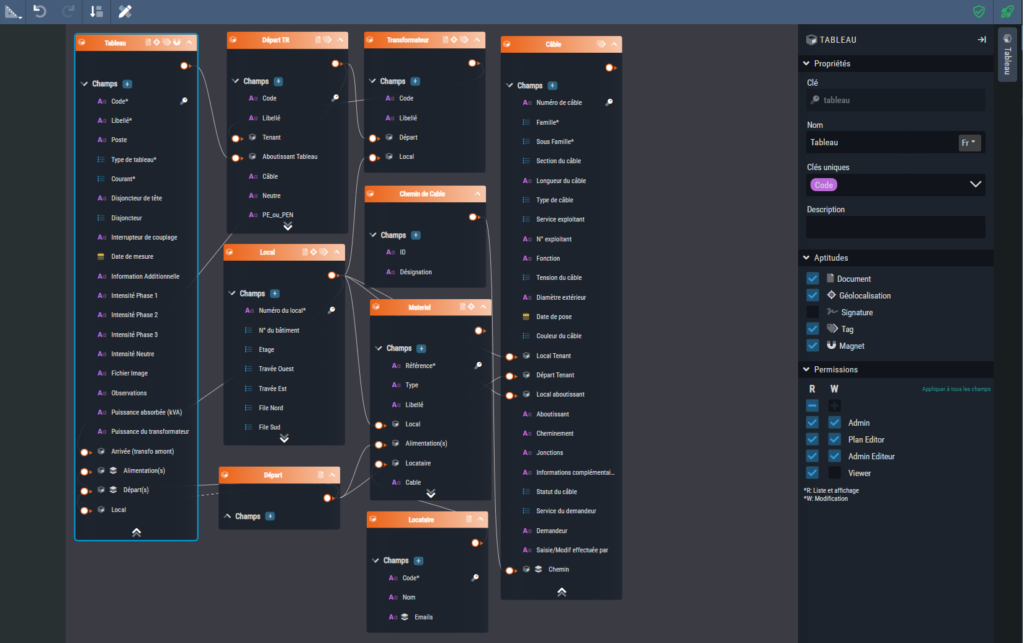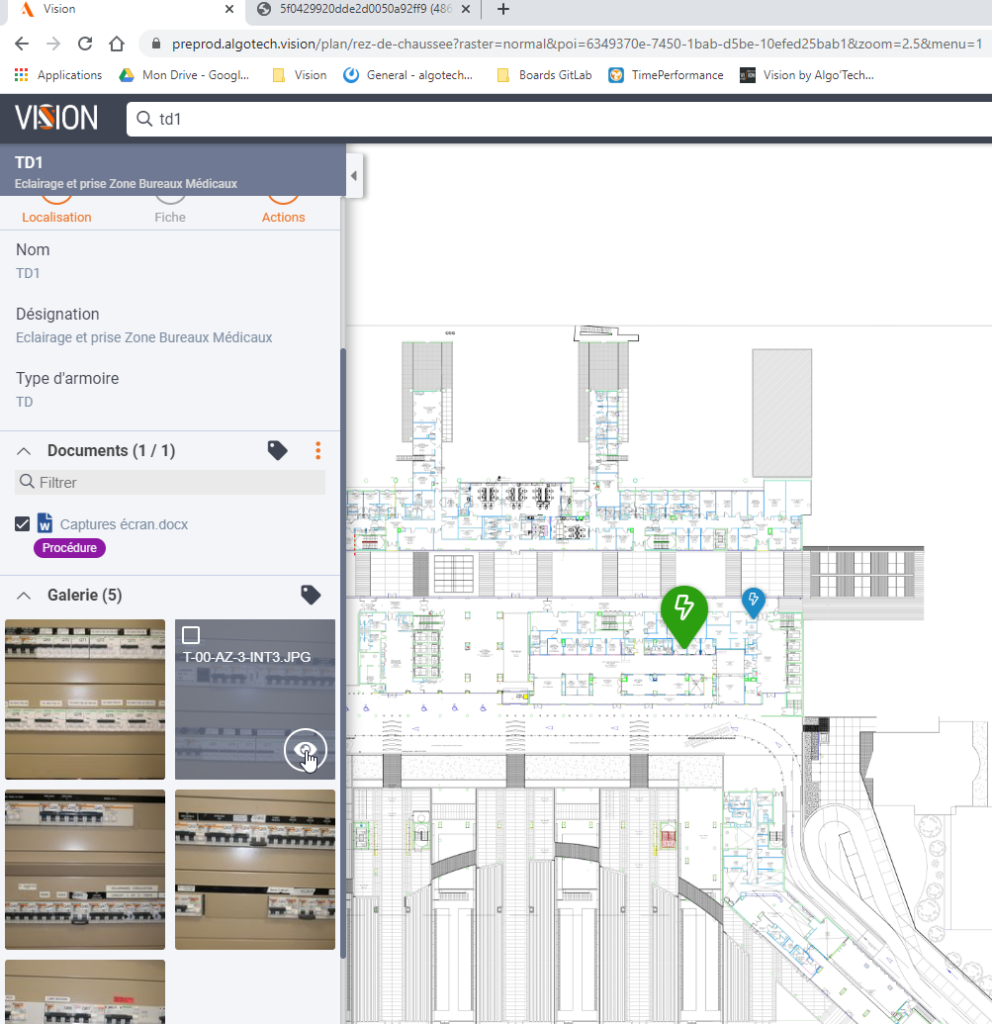
Vision, cas d’applications pour la gestion de vos réseaux techniques
Temps de lecture : 10 minutes
La gestion des énergies est devenue un enjeu crucial à l’échelle mondiale. Face aux défis posés par les changements d’approche d’usage des ressources fossiles et des énergies, il est judicieux d’évaluer comment le numérique peut favoriser des solutions durables et efficaces pour produire, distribuer et consommer mieux. Au-delà de l’efficacité énergétique, le numérique doit également aborder l’enjeu essentiel de la sécurité des biens et des hommes qui travaillent sur ces installations.
Les accidents d’origine électrique sont 15 fois plus souvent mortels que les accidents ordinaires. Le risque électrique en milieu de travail, s’il est mieux maîtrisé, reste toujours présent
(source : https://eduscol.education.fr)
L’énergie est au cœur de nos vies, qu’il s’agisse de nos maisons, de nos entreprises ou de nos infrastructures essentielles. Afin d’optimiser la gestion de cette énergie, il est crucial d’exploiter les avantages du numérique. L’un des aspects clés réside dans la collecte de données à grande échelle, souvent illustrée par l’Internet des objets (IoT) et les capteurs intelligents mais également par la capacité à collecter, transformer et diffuser la donnée par API, exploiter des plans, indexer des fichiers etc….
La technologie Vision par exemple permet de recueillir des informations précises sur la consommation d’énergie depuis un logiciel de GTE, les schémas de fonctionnement, les interventions de maintenance, les prochains travaux et bien plus encore pour permettre de les analyser, les gestionnaires peuvent ainsi prendre des décisions éclairées pour améliorer l’efficacité énergétique.
Vous souhaitez mettre en œuvre une politique de transformation numérique pour les métiers associés aux réseaux, quels que soient les types de fluides (Air, Eau, Gaz, Electricité…), et vous vous demandez par où commencer ? Vous trouverez ici quelques idées et retours d’expériences.
Au sommaire de cet article :
Par où commencer ?
Vous souhaitez mettre en œuvre une politique de transformation numérique pour les métiers associés aux réseaux, quels que soient les types de fluides (Air, Eau, Gaz, Electricité…), et vous vous demandez par où commencer ? Vous trouverez ici quelques idées et retours d’expériences.
En général vos sources de données sont multiples et très hétérogènes. La première étape consisterait à analyser vos sources de données disponibles schémas, plans, fichiers Excel, base de données, applications particulières et éventuellement entreprendre un inventaire physique et numérique. Faire ce tri est une étape importante permettant de récupérer un maximum d’informations pertinentes. En l’absence de données numériques, un scanning de documents peut s’avérer utile pour conserver une trace de ces documents.
A ce stade ce qui est important est de relier les différentes informations pour pouvoir y accéder de manière efficace et rapide – par exemple cela peut être :
- Sur la base du plan physique de vos bâtiments ou usines en localisant les différents équipements ou composant du réseau
- Dans un schéma fonctionnel de votre ou vos réseaux avec les tenants ou aboutissants
- Mais aussi par identification sur le terrain au travers d’un tag (QR code ou autre) de l’équipement concerné et de sa position dans le réseau
- Ou plus classiquement par une recherche basée sur son n° d’identification

Le Data modeler de Vision ainsi que le module Plan sont très utiles pour lier des informations diverses issus de système hétérogènes avec des modèles de données propres et permettre une visualisation et interaction sur un plan.
Un exemple de visualisation sur Plan? cliquez sur ce lien

Une fois les données collectées, il convient d’identifier les acteurs et leur rôle dans le traitement et la mise à jour de cette information :
- On va retrouver les principaux acteurs garants de la bonne mise à disposition des fluides, c’est-à-dire l’équipe d’exploitation, qui peut être interne ou externe suivant les cas de figure dans l’industrie ou le bâtiment. C’est elle qui coordonne les interventions et leur conséquence sur l’exploitation du bâtiment ou de l’infrastructure, en organisant les opérations de travaux, en coordonnant les interventions préventives et/ou réglementaires ; elle dispose d’une connaissance globale du patrimoine technique du bâtiment.
- En cas de problème, elle peut faire appel à l’équipe de maintenance qui est chargée de l’entretien préventif et des interventions curatives pour la remise en route des énergies. Cette équipe peut également être interne ou externe à l’entreprise en fonction du niveau de compétence et connaissance nécessaires (par exemple en électricité pour les réseaux HT, BT ou Courant faible on retrouvera différents types de compétences requises).
- Pour assurer la conformité des installations, un troisième type d’intervenant est l’organisme de contrôle. Ce dernier est chargé d’identifier les non-conformités (problème d’isolement, absence de schéma, sous-dimensionnement…) de les communiquer au responsable du site et de l’accompagner dans la résolution de ces réserves techniques. A ce titre il peut décider d’une coupure électrique, ou de l’entreprise d’un chantier de remise en conformité des installations ou des données fournies pour l’analyse des installations (schémas, notes de calcul etc…)
- Les entreprises d’installation dans le domaine de l’énergie et des réseaux associées à leurs/des bureaux d’études sont le point d’ancrage de l’information qui sera ensuite utilisée en exploitation. De ce fait, il convient de mettre en place (du moins pour les travaux d’ampleur) une charte de travail visant à la remise de données structurées et standardisées afin de pouvoir l’exploiter dans les meilleures conditions. Ainsi on demandera format spécifique pour les schémas, plans, la remise de fichiers de données (nomenclature, inventaires, localisation etc…). Dans ce domaine, le BIM apporte d’ailleurs beaucoup tant il permet d’agréger un maximum de données structurées en phase conception/construction, utiles ensuite à l’exploitation/maintenance.
- Enfin, le dernier acteur est non des moindre, c’est vous, moi, l’étage 7, le local ménage, l’étiquetteuse, le convoyeur…autrement dit tous les consommateurs des énergies. Ceux-ci ne peuvent en aucun cas admettre une coupure d’alimentation, ou pire se sentir en danger à proximité d’une installation électrique ou gaz par exemple. En ce sens, le bon déroulement de l’acheminement des énergies au consommateur est le garant de l’efficacité/l’optimisation de l’activité et de la mise en sécurité des personnes et des biens, et ceci tout secteur d’activité confondu.

Les procédures métiers liées aux réseaux d’énergie
L’étape d’après consiste à fournir les outils et procédures appropriés aux différents intervenants pour consulter et mettre à jour l’information. Évidement ces informations étant importantes il convient aussi de mettre en place des procédures de validation qui peuvent être adaptées aux différentes catégories d’interlocuteurs.
Cela nécessite de répondre aux questions sur l’identification des processus standard du métier à mettre en place et ceux propres à l’entreprise. Si on prend le métier Électricité par exemple, les exploitants dans le bâtiment ou l’industrie doivent mettre en place à minima les visites périodiques des installations et être en mesure de mettre à disposition de tout intervenant (mainteneurs, pompiers, police..), les informations de tenant-aboutissants pour connaître les différentes alimentations électriques et données afférentes. Ceci nécessite donc une organisation particulière et des outils pour assurer le suivi des interventions, comptes rendus et plans d’action, ainsi que des outils de supervision des documents techniques.
Au delà de ces actions, des procédures métiers standards, mais bien spécifiques à chaque entreprise, sont également nécessaires comme la consignation/déconsignation d’énergie, la diffusion d’avis de coupure, la mise en sécurité des intervenants (par exemple la minute de sécurité, le temps d’observation préalable qu’on retrouve chez EDF) ou encore les procédures internes de mise à jour lors d’opération de travaux (assimilation des DOE).
La mise en place d’une gouvernance de vos données
La gouvernance des données passe par une harmonisation des interventions humaines et des outils de traitement.
Commençons par l’humain :
Le CRUD (Create, Read, Update, Delete) défini en phase de modélisation de ses données est le garant du maintien à jour de l’information. Cette information étant souvent liée au terrain, il faudra s’assurer que les collaborateurs aient à disposition des terminaux mobiles pour accéder à l’information, la saisir ou la mettre à jour si nécessaire. On optera pour une étape de validation sur des données ou documents sensibles qui seront diffusées dans le système d’information. Ainsi, on responsabilise chaque personae qui sera garant du suivi d’une ou plusieurs informations particulières, depuis une interface qui lui est dédiée et facilement accessible.
Puis la machine :
Prendre conscience que la donnée a une valeur permet aux métiers de faire comprendre à l’informatique à quel point la gouvernance de ces dernières est importante. Ainsi cela favorise l’intégration de ces informations dans le système d’information et aide à ne plus être considéré comme du Shadow IT. Disposer d’un outil permettant cette intégration sans faire appel à des compétences particulières ou projets complexes est là encore un énorme avantage de Vision. La donnée est alors associée à des règles de gestion au sein de flux automatisés, de tâches planifiées ou de route d’accès pour des logiciels tiers
On voit clairement que les mêmes données peuvent avoir des usages très différents et qu’il est essentiel qu’elles soient fiables et à jour.

Les bénéfices pour les métiers
Aujourd’hui il est largement démontré qu’avoir une bonne connaissance de ses réseaux à un très fort impact sur :
- L’amélioration de la disponibilité des équipements
- La qualité et l’efficacité des interventions par un accès rapide et pertinent aux bonnes informations
- La mise en place d’applications métiers complémentaires comme :
- La gestion des consignations,
- La déclaration d’incidents,
- La mise en place d’avis de coupure automatique
- etc…
- La mise en place de politique de maintenance préventive voire prédictive
- La diminution des risques humains par une meilleure sensibilisation aux risques et un maintien en éveil
- La bonne gestion des relations avec les différents intervenants et notamment les sous-traitants
- La performance des opérations de travaux et de maintenance
C’est le socle nécessaire à la mise en place d’une politique de gestion efficace et optimisée des réseaux et la base pour une meilleure gestion des énergies.
Les avantages du No-Code dans ce domaine
Voici listés les différents avantages :
- Développer les applications dont vous avez besoin, adaptées à vos exigences et contraintes et connectez les à vos sources de données de manière simple, rapide et pas chère.
- Limiter la contrainte technique, ce qui permet de se concentrer sur le QUOI plutôt que sur le COMMENT.
- Gagner en expérience et devenir autonome pour réaliser et surtout faire évoluer des applications qui auraient normalement nécessité une expertise informatique particulière interne ou externe.
- Eviter les projets tunnels, progresser à votre rythme et constater des résultats à chaque mise en service de fonctionnalités.
- Supprimer le Shadow IT en offrant des outils adaptés à vos utilisateurs qu’ils peuvent, avec un support très léger des équipes informatiques, utiliser et faire évoluer eux même ; et ceci en respectant les enjeux de sécurité et d’exploitation informatique.
- Réduire le nombre de vos applications SaaS en rationalisant dans une plateforme la gestion de vos flux de données utiles à votre activité.
- Réduire le coût de vos applications et vous permettre de mieux piloter vos activités par la donnée
- Créer des interfaces adaptées à chaque personae et action à réaliser pour favoriser l’adoption et l’usage des applications.
- Se connecter facilement à différentes sources de données, savoir dynamiquement harmoniser des modèles de données hétérogènes pour utiliser de manière cohérente et consistante vos données.
Enseignements et projections
Les métiers liés aux réseaux sont encore pauvres en transformation numérique, le papier est encore légion et la difficulté d’obtenir des données fiables est de plus en plus complexe. On dit que dans ces métiers plus de 20% du temps est passé à chercher de l’information.
Avec la nécessité de mettre en place une politique de régulation et d’optimisation de l’usage des énergies, les équipes en charge de la transformation numérique ont une formidable opportunité pour lancer des projets d’inventaire et d’identification des réseaux et des équipements pour en créer des bases de connaissances. Ces dernières serviront à la fois à sécuriser les interventions mais également à identifier des axes d’optimisation (exemple sur les puissances ou débits devenus inadéquats avec le temps).
Ici encore, le No Code permettra de rapidement se connecter aux sources de données externes par exemple une solution de Gestion Technique des Energies, pour mutualiser les données (locaux, équipements, puissance, volume, surfaces…)
Pour les mainteneurs, c’est également une possibilité de compléter les outils de GMAO avec une application intégrée dédiée aux métiers de réseaux comme les électriciens, plombiers, chauffagistes etc…
Pour les organisations l’occasion de collecter de la donnée utile afin d’améliorer les procédures et pratiques pour gagner en efficacité, sécurité des individus, mettre en place des politiques de prévention,…..
– article rédigé le 06 juin 2023
Vision par Algo’tech est une plateforme No-Code de création d’applications professionnelles, tout en un.
Créez vos interfaces utilisateur mobile & desktop + la base de données qui les alimente + les process pour guider l’utilisateur dans l’application + les connexions d’API.
La plateforme vous propose aussi d’héberger vos créations dans un espace centralisé pour gérer plusieurs applications, les utilisateurs et leurs droits.


